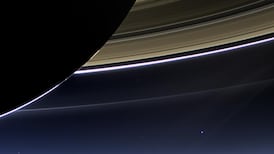European space scientists are about to attempt one of the most daring operations ever undertaken in interplanetary flight. They are due to direct their Jupiter Icy Moons Explorer (Juice) to make a fly-by of Earth and its moon – and carry out the first double gravity-assist manoeuvre in space.
A team of astrophysicists from the Dublin Institute for Advanced Studies will help with the manoeuvre, due to be carried out on Monday and Tuesday, by carrying out tests remotely to ensure the spacecraft is on the right trajectory.
The high-risk exercise is vital to the success of the European Space Agency (ESA) mission and is aimed at taking the €1.6 billion robot craft to its target, Jupiter, by 2031. There it will begin exploration of two of the giant planet’s moons, Europa and Ganymede, in a bid to find signs of life that may lurk in their ice-covered oceans.
The manoeuvre will require extraordinarily accurate navigation as the slightest mistake could take Juice off course and doom the mission, the ESA said.
READ MORE
“It’s like passing through a very narrow corridor, very, very quickly: pushing the accelerator to the maximum when the margin at the side of the road is just millimetres,” said Juice’s spacecraft operations manager, Ignacio Tanco.
It is an extraordinary interplanetary waltz requiring Juice to travel at exactly the right speed, time and direction for each encounter. However, without such precise manoeuvring, space engineers simply could not explore the Sun’s more remote planets, the ESA said. It may be possible to spot the spacecraft in the sky as it hurtles by the earth.
To fly straight to Jupiter would require Juice to carry 60,000kg of propellant, an unfeasible load, explained Prof Caitríona Jackman of DIAS Planetary Magnetospheres Group – she is working on the mission with colleagues Dr Mika Holmberg and Dr Hans Huybrighs.
In energy terms, it has been described as getting shots of espresso coffee along the way. In addition, it would need more fuel to slow down so that it could enter into orbit around the planet. That means the scenic route, using the inner planets to gain gravitational assists to reach its target, is the only way to get to the outer solar system.
This fly-by is hugely important as it’s one of the few opportunities to make certain measurements and adjustments during Juice’s eight-year journey to Jupiter, Prof Jackman said. “The lunar-Earth fly-by will be an opportunity for the DIAS team to test their ideas about the spacecraft’s behaviour in the environment of a moon, in preparation for the actual fly-bys of Jupiter’s moons.”
“We will be monitoring the fly-by with trepidation as it’s an extremely challenging undertaking – the slightest mistake could take Juice off course and spell the end of the mission,” she said
“This is the first step in Juice’s journey through the solar system on its way to Jupiter. The spacecraft will use the gravity of the Moon and then Earth to bend its path through space and redirect it on course for a fly-by of Venus in August 2025,” she said.
“The encounter of Earth’s moon is a practice-run for when we get to Jupiter, where we will study moons with underground oceans that might support life. I’m extremely proud of the work carried out by our research group so far, and that we can be part of such an important mission.”
Dr Huybrighs, who is working on the “particle environment package instrument”, said studying the abilities of Jupiter’s moons to host life, required accurate and detailed measurements.
He said: “Jupiter’s moons slowly release particles from their surface. In some cases, this release could happen through water eruptions that produce 100-kilometre-tall plumes. By detecting these particles, we can learn more about the moons’ potential to support life. Investigating how Juice can best detect these plumes is one of the topics we are working on at DIAS.”
They will also explore how the spacecraft itself affects measurement of particles, said Dr Holmberg, co-investigator on the radio and plasma wave investigation instrument.
“The measurements from the lunar-Earth fly-by could have a significant impact on our research ... The effects of the interaction between the spacecraft and its environment influences our interpretation of the measurements. For example, it might change our understanding of where the moon particles that we are trying to detect come from, or how many there are.”
The computer simulations account for the environment of the spacecraft and models how the moon particles will be affected, “so that we can correct potential misleading effects for later in the mission”, she said. “When Juice flies by the Moon we have the first opportunity to test our correction techniques during an actual moon encounter, which is exciting. It’s the perfect opportunity for us to calibrate our instruments and smooth out any remaining issues, and who knows what it could lead to.”
The mission involves 18 different research institutes; 23 countries and 83 different companies with more than 2,000 people involved. DIAS participation is funded by Science Foundation Ireland and supported by ESA. – additional reporting Guardian
- Sign up for push alerts and have the best news, analysis and comment delivered directly to your phone
- Join The Irish Times on WhatsApp and stay up to date
- Listen to our Inside Politics podcast for the best political chat and analysis













